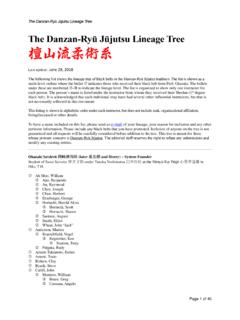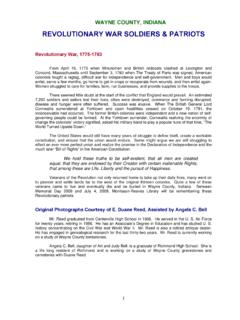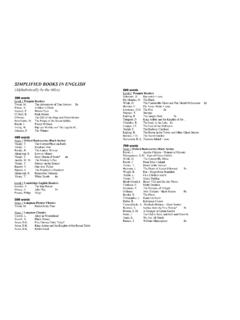Transcription of THE NATIONAL ARCHIVES PROB 11/57/612 1 …
1 THE NATIONAL ARCHIVES prob 11/57/612 1 _____ Modern spelling transcript copyright 2008 Nina Green All Rights Reserved SUMMARY: The document below is the Prerogative Count of Canterbury copy of the will, dated 24 October 1575, together with a codicil dated 16 November 1575, proved 16 December 1575, of Richard Blount alias Leigh of Coleman Street, London, from whose widow, Margaret Bostock, Oxford leased the mansion of Fisher s Folly in Bishopsgate (see below). A further connection with Oxford is indicated by the testator s bequest of a ring of gold worth 40 shillings to his neighbour, Master Golding. The will of Mary Golding indicates that the testator s neighbour was Oxford s maternal uncle and auditor, George Golding, who was buried at St Stephen s, Coleman Street, on 27 November 1584 (see the will of Mary Golding, TNA prob 11/119/379). Other neighbours of the testator would have been James Burbage ( ), whose sons Cuthbert Burbage (1564/5-1636) and Richard Burbage (1568-1619) were baptized at St.
2 Stephen s in Coleman Street in 1565 and 1568, respectively; the painter Marcus Gheeraerts ( ), who was living in Coleman Street by 1571; and the family of the carpenter Peter Street ( ), who was baptized at St. Stephen s in Coleman Street in 1553 and who later built the Globe theatre. These connections with the Burbages and the builder of the Globe are of particular interest since the will below indicates that the testator also had connections to the Pope and Kempe families, and the actors Thomas Pope and Will Kempe, both of whom called themselves gentlemen, were later co-lessees in the ground lease of the Globe with William Shakespeare of Stratford upon Avon. FAMILY BACKGROUND The testator was the illegitimate son of Sir John Leigh or Legh (1502-1564?), for whose will see TNA prob 11/48/372. See: Edward Hasted, 'Parishes: Stansted', in The History and Topographical Survey of the County of Kent: Volume 5 (Canterbury, 1798), pp.
3 1-5. British History Online [accessed 26 September 2018] They, in the next reign of king Henry VII. joined in the sale of this manor to Thomas Leigh, of Sibton, in Lyminge, whose son John Leigh, esq. was of Addington, in Surry, and he died possessed of it in 1544. His grandson of the same name, in the 5th year of queen Elizabeth, devised it to Richard Blunt, alias Leigh, his natural son, for a long term of years, and died in 1576. Sir John Leigh s half brothers and sisters included Queen Katherine Howard; Oxford s friend, Sir George Howard ( ); and Margaret Howard ( ), the mother of Oxford s one-time friend and later bitter enemy, Charles Arundel ( ). Testator s father s marriage to Elizabeth Darcy THE NATIONAL ARCHIVES prob 11/57/612 2 _____ Modern spelling transcript copyright 2008 Nina Green All Rights Reserved The testator s father, Sir John Leigh, married, by 1522, Elizabeth Darcy, the daughter of Roger Darcy ( ) of Danbury, Essex, Gentleman of the Chamber to Henry VII, by Elizabeth Wentworth (living 1542), the daughter of Sir Henry Wentworth ( - August 1499) of Nettlestead, and sister of Margery Wentworth ( ), who married Sir John Seymour (1473/4-1536) of Wolf Hall, and was the mother of Queen Jane Seymour, third wife of King Henry VIII, and of Edward Seymour ( ), Duke of Somerset.
4 See the will of Sir Henry Wentworth, TNA prob 11/12/265, and Hooper, Hilda J., Some Surrey Wills in the Prerogative Court of Canterbury, Part I , Surrey Archaeological Collections, Vol. LI, (Farnham: E. W. Langham, 1950), p. 86 at: #page/86/mode/2up By Elizabeth Darcy, the testator s father had a daughter: * Agnes Leigh (d. before 1590), the testator s half sister. She is bequeathed a gold ring in the will below: Item, I give to my very good Lady Paston a gold ring of the value of three pounds six shillings and eight pence. Agnes Leigh married firstly, by 1544, Sir Thomas Paston ( 4 September 1550), Gentleman of the Privy Chamber to Henry VIII, the fourth but third surviving son of Sir William Paston (c. 1479 1554) and Bridget Heydon, by whom she had two sons and a daughter: -Henry Paston (d. by 1575), eldest son and heir. See Hodson, , Sudbury College and Archbishop Theobald , Proceedings of the Suffolk Institute of Archaeology and Natural History, Vol.
5 VII, 1891, pp. 23-32 at pp. 30-1: -Sir Edward Paston (1550-1630), who married firstly Elizabeth Lambert, the daughter of Richard Lambert of London, by whom he had no surviving issue, and secondly Margaret Berney ( ), the daughter of Henry Berney of Reedham, by whom he had six sons and three daughters. See the ODNB entry. -Katherine Paston, who married Henry Newton ( 2 May 1599), for whom see the History of Parliament entry at: For Sir Thomas Paston, see his will, dated 7 October 1549 and proved 8 November 1550, TNA prob 11/33/406, the ODNB entry, and the History of Parliament entry at: THE NATIONAL ARCHIVES prob 11/57/612 3 _____ Modern spelling transcript copyright 2008 Nina Green All Rights Reserved Agnes Leigh married secondly Edward Fitzgerald, a younger brother of Gerald FitzGerald, 11th Earl of Kildare (1525-1585), by whom she had four sons and at least two daughters.
6 See the History of Parliament entry for Edward Fitzgerald at: See also Worship, Francis, Account of a MS. Genealogy of the Paston Family , Norfolk Archaeology, Vol. IV, (Norwich: Charles Muskett, 1855), pp. 44-5 at: See also Jones, Mrs. Herbert, Sandringham, Past and Present, 2nd ed., (London: Sampson Low, 1883), p. 315 at: Testator s siblings The testator and his two brothers used the surname Blount , and it thus seems all three were the illegitimate sons of Sir John Leigh by a mistress of that surname. Since the testator s sisters are identified in the will below only by the surnames of their husbands, it is not known whether they were the testator s sisters of the whole blood, or whether they were Sir John Leigh s daughters by a different mistress or mistresses. In the will below the testator mentions two brothers and four sisters: -Robert Blount, who married and had issue, including a son, Richard Blount, and another unnamed son, both of whom were under twenty-four years of age when the testator made his will.
7 -Thomas Blount, who according to TNA C 3/11/100, infra, was a cleric. -Agnes Blount(?), who married a husband surnamed Milliton, by whom she had issue. -Elizabeth Blount(?), who married a husband surnamed Haffehede, by whom she had issue. The testator also mentions his niece, Ursula Haffehede , who married Digbie . This appears to be Ursula Halfehead of London, who married John Digby, son and heir of Henry Digby and Margaret, his wife. See Fetherston, John, ed., The Visitation of the County of Leicester in the Year 1619, (London: Harleian Society, 1870), Vol. II, p. 87 at: #page/86/mode/2up THE NATIONAL ARCHIVES prob 11/57/612 4 _____ Modern spelling transcript copyright 2008 Nina Green All Rights Reserved -Maud Blount(?), who married a husband surnamed Seymour, by whom she had issue, including a daughter, Elizabeth Seymour, who was married at the time the testator made his will.
8 -Anne Blount(?), who married a husband surnamed Robson, by whom she had a son, Thomas Robson, who was under the age of twenty-one at the time the testator made his will. Testator s cousins The History of Parliament entry for the testator acknowledges that the testator cannot be placed in the Blount pedigree, but notes that he is connected through the will of Sir Hugh Paulet and through his own will to members of a particular branch of the Blount family: Blount may have been born in Stafford, a member of the family of Knightley, Staffordshire, and Kinlet, Shropshire. Several persons of this name flourished during the 1550s including one who was usher of Queen Mary s Chamber until 1556 but none can be definitely identified as the man who sat for Taunton. Whatever his origins the 1571 and 1572 Taunton Member lived at Williton, some 12 miles away, and there is a presumption that his candidature must have been at least tolerated by Sir Hugh Paulet, who was one of those asked by the Privy Council to ensure that suitable Members were returned throughout the county.
9 In fact Blount may have been in the service of the Paulets; he was an overseer of Sir Hugh s will, and on his own death, 16 Nov. 1575, he bequeathed a cross of gold with four diamonds and a portique of gold to his very good lady and friend (and possibly even relative, for she was n e Blount) Lady Paulet (Sir Hugh s wife), and instructed his widow, the sole executrix, to return all such chests and goods which, of trust in the time of my lady her absence, remain in my home and were delivered unto me to be kept for her . Another patron was Lady Siddenham, wife of Sir John Siddenham, to whom he bequeathed a table diamond . He provided for the maintenance of a poor scholar to be nominated by the town of Stafford at Oxford and left 100 to the fellows of Trinity College. The attorney-general Sir Gilbert Gerard, the solicitor-general Thomas Bromley and Lady Paulet were among the overseers of his will, which was proved 16 Dec.
10 1575. Blount s widow married as her second and third husbands Jasper Fisher and Nicholas Saunders . In the will below, the testator states that he was born in Stafford, and mentions his cousin, William Blount of Osbaston, Leicestershire, as well as William Blount s daughters, Barbara Blount and Ursula Blount. It thus appears that he was a member of the branch of the Blount family of Burton upon Trent and Blounts Hall in Stafford. See Croke, Alexander, The Genealogical History of the Croke Family Originally Called Le Blount, (Oxford: W. Baxter, 1823), pp. 288-307 at: THE NATIONAL ARCHIVES prob 11/57/612 5 _____ Modern spelling transcript copyright 2008 Nina Green All Rights Reserved #page/288/mode/2up Since Croke s pedigree establishes the identity of a number of persons mentioned in the will below, it is useful to summarize it here. According to Croke, John Blount ( ), esquire, of Burton upon Trent and Blounts Hall, Staffordshire, married Ellen Hall, the daughter of John Hall, esquire, of Dovebridge, by whom he had two sons (and perhaps a daughter, Anne Blount, who married Thomas Blackwell ( ), son of Richard Blackwell of Blackwell, Derbyshire?)






